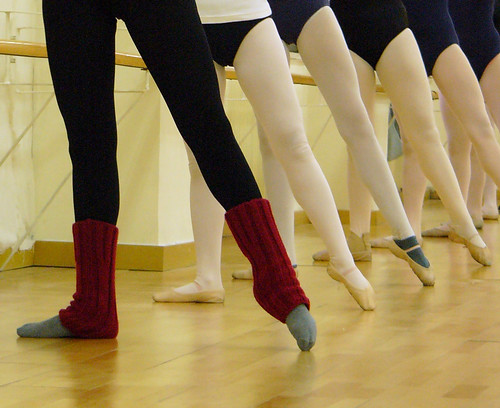
Dance teachers often emphasize the use and strengthening of the inner thigh in dance class.
Let’s concentrate on two important things that muscles of the inner thigh do:
- Stabilize outward rotation (or turnout),
- Adduct (or pull the legs together or toward the center line of the body).
If you think about your dance or ballet training, perhaps you can already see why your teacher might consider the inner thigh muscles worthy of attention.
Strong inner thigh muscles help a dancer to maintain turnout in standing and some help when the leg is lifted in turnout.
It is a general misconception that these are active rotators in turnout. Instead, the inner thigh muscles (or more specifically those that adduct and outwardly rotate) stabilize and support the rotation which the six deep rotators work to achieve. Strong adductors (which make up what we consider the inner thigh) also allow the dancer to be quick and agile particularly in movements which beat or require a quick closing of the legs. From tendu to grand battement to assemblé sauté to entrechat quatre, a quick and precise sort of strength is necessary for ballet as well as many other dance forms.
Students often mistakenly think that targeting this muscle group with strengthening exercises will suddenly improve the height of their extended leg, or the speed of their battu. The truth is, that the best way to strengthen these muscles is through conscientious and consistent working on technique.
Of course, doing a bit of additional, focused work can certainly encourage awareness and therefore improvement of technique and strength. Therefore, I am including some exercises that may help you develop such an awareness of the various muscles in your inner thigh. These can be used to target muscle groups for strengthening, should you be particularly weak in this area or tend to overwork the quads and gluts (not uncommon in dancers). However, talk with your teacher or physiotherapist to decide if you really need to begin a regimen.
Overall, I suggest you use these exercises to learn and discover information that you can then use in your daily/weekly classes.
(You don’t necessarily need a ball for the exercise above, just about anything will do. This demonstration is done with a tennis shoe – click here)
Please note that I do not endorse or sponsor any of the above websites or programs affiliated with these videos. They simply provided good visual examples of the exercises.
Additional exercises:
- Lie on your back with the feet lifted to the ceiling. The legs are in a turned out first position and pointed. From here open the legs wide to a straddle position and then close together while flexing the feet. The movement should be controlled and smooth in both directions and done in a series. You might also add beats, etc.
- Create a small loop with an exercise band (Theraband) and place it around your ankles. Stand in first or fifth position and tendue or point the leg in any direction (front, side, or back). Execute small lifts of the leg (make sure you are properly turning out both the working and supporting leg and lifting tall through the body – if you aren’t sure, do this exercise only in the presence of your teacher so that corrections can be made if necessary). You could also try rond de jambe or other small battement.
Do you have a great inner thigh exercise (or awareness builder) to share?
Nichelle Suzanne is a writer specializing in dance and online content. She is also a dance instructor with over 20 years experience teaching in dance studios, community programs, and colleges. She began Dance Advantage in 2008, equipped with a passion for movement education and an intuitive sense that a blog could bring dancers together. As a Houston-based dance writer, Nichelle covers dance performance for Dance Source Houston, Arts+Culture Texas, and other publications. She is a leader in social media within the dance community and has presented on blogging for dance organizations, including Dance/USA. Nichelle provides web consulting and writing services for dancers, dance schools and studios, and those beyond the dance world. Read Nichelle’s posts.

